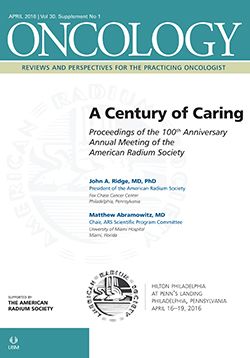(S003) Single-Fraction Radiation Therapy for the Treatment of Multiple Myeloma Bony Metastases Provides Pain Control and Decreases Time to Chemotherapy
A hypofractionated course of 8 Gy/1 fx radiation therapy in the treatment of bony multiple myeloma metastases is an efficient and effective way to reduce pain and reduce the time from the completion of radiation therapy to the start of chemotherapy in patients with multiple myeloma.
Tijana Skrepnik, MD, April Brookshier, Amit Agarwal, MD, PhD, Krisha J. Howell; University of Arizona
INTRODUCTION: Seventy percent of all patients with multiple myeloma (MM) receive radiation therapy (RT) in the course of their illness. The most standard MM radiation fractionation consists of ≥ 10 treatments. Randomized phase III trials have proven single-fraction RT to be equivalent to protracted-course RT for bony metastatic sites from breast, prostate, and lung. We reviewed single-dose hypofractionated RT against standard fractionation as administered to MM patients.
METHODS: Diagnosed MM patients treated on our palliative service with RT for bony sites of disease within the past 3 years were reviewed. A total of 21 treatment sites were identified. Sites were treated with a single-dose, hypofractionated RT treatment of 8 Gy in one fraction (fx) or a standard RT course for MM. Data on treatment toxicity (Common Terminology Criteria for Adverse Events version 4.0) of patients while on treatment and at the time of follow-up(s) were collected prospectively. Pain was assessed by the visual analog scale.
RESULTS: We analyzed a total of 17 sites of bony metastases secondary to MM that were treated at our center. Ten sites received hypofractionated RT (8 Gy/1 fx). RT was completed in 16 of 17 sites. Median clinical follow-up was 5.13 months. Median pain scores at the start of RT and time of maximum improvement were 10 and 0, respectively. The response rate was 70.5%, and zero patients had progression of pain. Nine patients had a complete pain response, to a final score of 0, and two patients had a partial response, with a decrease of 2 or more points in their pain. The median time from RT to start of chemotherapy was 1.07 months. A decreased time to start of chemotherapy was evident in the 8 Gy/1 fx subset.
CONCLUSIONS: A hypofractionated course of 8 Gy/1 fx RT in the treatment of bony MM metastases is an efficient and effective way to reduce pain and reduce the time from the completion of RT to the start of chemotherapy in patients with MM.
Proceedings of the 98th Annual Meeting of the American Radium Society - americanradiumsociety.org
